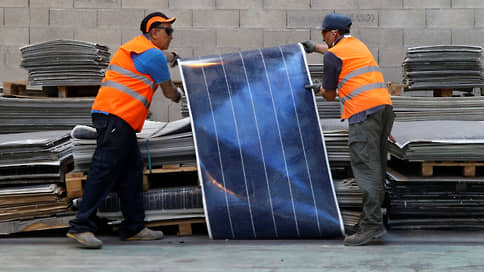Very environmentally friendly, but terribly toxic – Hi-Tech – Kommersant
[ad_1]

Solar energy is considered one of the most environmentally friendly types. However, it also has negative consequences from the environmental point of view – solar panels that have exhausted their life are so difficult and expensive to recycle that not everyone undertakes it. As a result, experts say, by 2050 the world could accumulate up to 78 million tons of unusable solar panels.
California is one of the pioneers of mass solar energy. It has been actively developing here for more than 20 years. Since 2006, the state has run a program that encourages homeowners to install solar panels on their rooftops and make more use of the energy they generate. $3.3 billion has already been allocated for subsidies in this area. As a result, California has about 1.3 million solar panels installed on private homes, and more than 17% of all electricity in the state account for for solar energy.
Such panels are designed for an average of 25-30 years of use. Many of them are now at the end of their service lives. The same problem exists – or will soon appear – in other countries. According to the forecasts of the International Renewable Energy Agency, large volumes of used batteries will accumulate in the early 2030s. By 2050, their volume, under a bad scenario, will reach 78 million tons. The leaders in the amount of such waste will be China (20 million tons), the USA (10 million tons), Japan and India (7.5 million tons each).
Although solar panels make up a small fraction of the volume electronic waste, there are several additional problems with them. First, if not properly recycled, solar panels are more likely than many other gadgets to pollute the environment with toxic heavy metals such as lead, selenium, and cadmium. Secondly, their processing is more difficult and more expensive than most other devices.
“This garbage will probably arrive faster than we expected … While all attention has been focused on creating renewable capacities, little attention has been paid to the end of their service life,”— thinks Serasu Duran, lecturer at the Haskeyn School of Business at the University of Calgary.
In her opinion, the industry’s capacities are “terribly unprepared for the flow of garbage that is likely to come.”
The problem is the behavior of the owners of the panels. Many of them are not aware of their toxicity and do not think about proper disposal. According to Sam Vanderhoof, CEO of battery recycling company Recycle PV Solar, only one in 10 panels are properly recycled, with many ending up in regular landfills.
Most solar cells are 80% recyclable, but breaking them down into their individual components is very difficult.
Recycling requires special equipment and skilled workers – for example, in order to separate the aluminum frame and switchboard from the panel without breaking the glass part of the panel.
A.J. Orben, vice president of another panel recycling company, We Recycle Solar, said one of the challenges is that many states have stringent regulations for handling toxic materials that are recovered from panel recycling. This makes the process even more expensive. So, due to strict regulation in California itself, the company transports panels from there to a plant in Arizona. Just last year, the California Toxic Substances Administration softened rules – before, all panels were considered poisonous and required special storage and transportation conditions.
At the same time, such processing is not a very profitable business. From each panel, it is possible to obtain materials for $2−4. And even with mass processing, this process does not become economically viable. According to the US National Renewable Energy Laboratory, recycling of one battery costs $20-30. “This industry was supposed to be green. But in fact, everything is tied to money,” says Mr. Vanderhoof.
According to many experts, good ways to encourage panel recycling are to subsidize such activities and make manufacturers responsible for their own recycling. In the EU, similar rules are already in place, requiring manufacturers to maintain equipment throughout its life cycle and to recycle it when it is no longer used. In the US, this requirement exists only in one state – Washington. It was adopted in 2017, but will only come into effect in 2025.
Another way to avoid the catastrophic accumulation of toxic waste is to create uniform standards for solar panels. This will greatly simplify their processing, but requires serious political decisions, which no one thinks about yet.
[ad_2]
Source link





